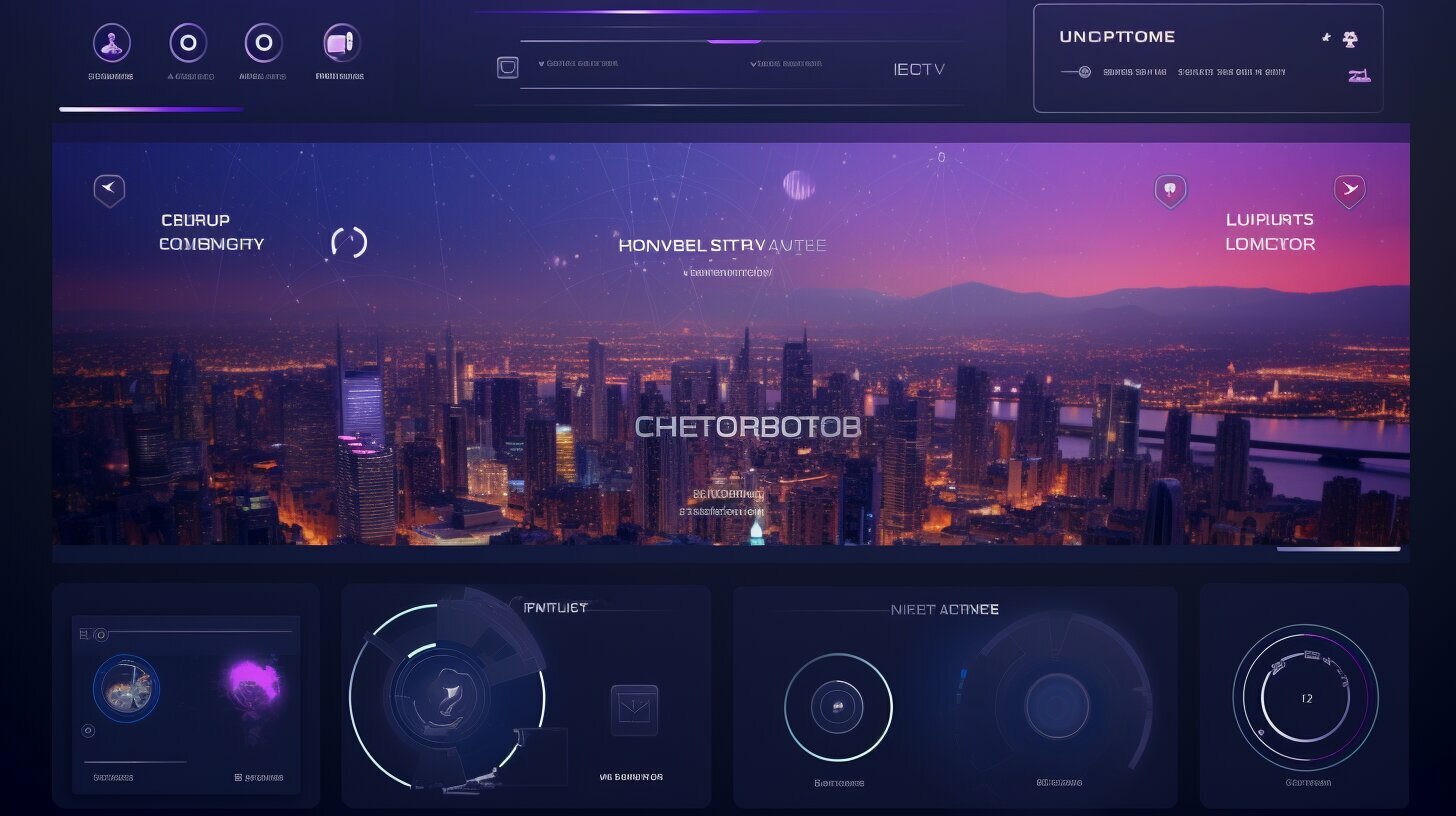Designing landing pages for digital services is a crucial aspect of any business’s digital marketing strategy. Landing pages are specifically designed webpages with the objective of converting visitors into leads or customers. With careful planning and implementation, a well-designed landing page can greatly enhance the effectiveness of your digital campaigns and drive valuable conversions.
In this comprehensive guide, we will explore the best practices for designing landing pages that effectively engage your target audience and maximize conversions. From crafting a benefit-focused headline to optimizing for search engines, we will cover a range of strategies and techniques to help you create compelling landing pages for your digital services.
Key Takeaways:
- A well-designed landing page is crucial for converting visitors into leads or customers.
- Best practices include crafting a benefit-focused headline and choosing relevant images.
- Compelling copy, clear calls-to-action, and relevant incentives can greatly improve landing page performance.
- Placing lead forms above the fold and removing navigation can enhance user experience and increase conversions.
- Tracking and analyzing landing page performance is essential for making data-driven improvements.
The Importance of Landing Page Design
A well-designed landing page plays a key role in optimizing user experience and boosting conversion rates for digital services. In today’s competitive online landscape, it is crucial to create landing pages that not only attract visitors but also guide them towards taking the desired action, whether it’s filling out a form, making a purchase, or subscribing to a service.
Effective landing page design focuses on elements such as web design and user experience, which greatly influence the overall conversion rate optimization. A visually appealing and user-friendly layout can positively impact visitors’ perception of a brand and its credibility. It is important to ensure that the landing page follows a clear, logical structure, with easy navigation and intuitive features that guide users towards the desired goal.
Furthermore, the content on the landing page plays a crucial role in capturing visitors’ attention and keeping them engaged. Compelling copy that clearly communicates the value proposition and benefits of the digital service being offered can make a significant difference. The use of persuasive language, strong headlines, and concise messaging can effectively convey the unique selling points and encourage visitors to take the next step.
| Key Elements of Landing Page Design | Description |
|---|---|
| Benefit-Focused Headline | A well-crafted headline that highlights the main benefit of the digital service to capture visitors’ attention and encourage them to explore further. |
| Relevant Images | High-quality and visually appealing images that align with the digital service being offered, creating an emotional connection with the visitors. |
| Compelling Copy | Clear, concise, and persuasive messaging that communicates the value proposition, benefits, and call-to-action to guide visitors towards conversion. |
| Lead Forms Above the Fold | Placing lead capture forms prominently on the landing page, ensuring they are visible without the need for scrolling, to encourage visitors to submit their information. |
By implementing these best practices and continuously tracking and analyzing the performance of landing pages, businesses can optimize their digital marketing efforts, improve conversion rates, and ultimately drive growth. Whether it’s through the use of A/B testing, heatmaps, or other analytics tools, gaining insights into visitor behavior can lead to data-driven improvements and more effective landing page designs.
Crafting a Benefit-Focused Headline
A benefit-focused headline is the first element that grabs a visitor’s attention and entices them to explore your digital services further. It should clearly communicate the value or solution your services provide, compelling the visitor to continue reading and take action. To create an effective benefit-focused headline for your landing page, consider the following strategies:
- Know your target audience: Understand the pain points, needs, and desires of your target audience. Tailor your headline to address their specific concerns and highlight the benefits they can expect from your digital services.
- Keep it concise: Capture the essence of your offering in a few words. Avoid long-winded or vague headlines that may confuse or lose the reader’s interest.
- Focus on the outcome: Highlight the end result or transformation that your digital services can deliver. Whether it’s increased efficiency, improved productivity, or enhanced customer satisfaction, emphasize the positive impact your services can have on the visitor’s life or business.
Example: “Boost Your Online Sales with Our Data-Driven Marketing Solutions”
By crafting a benefit-focused headline, you can quickly convey the value of your digital services and engage visitors, increasing the likelihood of them exploring your offering further. Remember to test different headlines and analyze the performance to optimize your messaging for maximum impact.
| Benefits of a Benefit-Focused Headline: | Examples: |
|---|---|
| Grabs immediate attention | “Increase Your Website Traffic by 200%” |
| Addresses visitor’s pain points | “Simplify Your Accounting with Our Automated System” |
| Creates curiosity | “Discover the Secret to Successful Email Marketing” |
| Highlights unique selling proposition | “Unleash Your Creativity with Our Innovative Design Software” |
Choosing Relevant Images
Carefully chosen and relevant images can significantly enhance the visual appeal and effectiveness of your landing pages for digital services. When designing your landing page, consider incorporating images that align with your brand identity and depict the product or service you are promoting. High-quality visuals not only capture the attention of your visitors but also help convey your message more effectively.
The Power of Visuals
Visual content has become increasingly important in digital marketing, as it is often more engaging and memorable than written content alone. Studies have shown that people process images faster than text and are more likely to retain information presented visually. By choosing images that are relevant to your digital service, you can create a visual representation of the value your product or service offers, making it easier for visitors to understand and connect with your message.
“A picture is worth a thousand words.” This famous quote holds true for landing page design. Images can evoke emotions, inspire trust, and communicate the benefits of your digital service in a more compelling way. However, it is important to strike a balance and not overcrowd your landing page with too many images. Select a few impactful visuals that highlight key features or benefits and use them strategically to support your copy.
| Benefits of Relevant Images: |
|---|
| Increases visual appeal |
| Enhances user experience |
| Communicates your message effectively |
| Elicits emotions and builds trust |
| Establishes brand identity |
In summary, selecting relevant images for your landing pages is an essential element of effective landing page design. These visuals can enhance the overall aesthetic appeal, engage your audience, and convey your message in a more impactful way. Remember to choose images that align with your brand and clearly communicate the value of your digital service. When used strategically, images can significantly contribute to the success of your landing page and improve your conversion rates.
Writing Compelling Copy
Compelling and persuasive copy is essential in guiding visitors to take action and convert into leads or customers for your digital services. The words you choose and the way you present the information can make a significant impact on whether visitors stay engaged and take the desired action or leave the landing page. Here are some key tips for writing compelling copy that drives conversions.
Create a Clear and Concise Message
When crafting copy for your landing page, it’s crucial to convey your message in a clear and concise manner. Keep your sentences short and to the point, focusing on the benefits and value your digital services provide. Use bullet points or numbered lists to break down complex information and make it easier to digest. By presenting your message clearly, visitors will understand the value of your services and be more compelled to take action.
Highlight the Unique Selling Proposition
Your landing page copy should clearly communicate your unique selling proposition (USP). What sets your digital services apart from the competition? Whether it’s faster turnaround times, innovative features, or exceptional customer support, make sure to highlight your USP prominently in your copy. This will help visitors understand why they should choose your services over others and increase the likelihood of conversion.
Use Social Proof and Testimonials
One effective way to build trust and credibility is by incorporating social proof and testimonials into your landing page copy. Include quotes from satisfied customers or showcase positive reviews to demonstrate the value and quality of your digital services. People are more likely to take action when they see that others have had a positive experience with your services.
Utilize a Call-to-Action
A compelling call-to-action (CTA) is essential for guiding visitors to take the next step. Use action-oriented language and place your CTA prominently on the landing page. Whether it’s “Sign Up Now,” “Get Started,” or “Request a Demo,” make sure your CTA is clear, concise, and visually stand out. A strong CTA can significantly improve the conversion rate of your landing page.
| Landing Page Copy Checklist: |
|---|
| ✓ Clear and concise message |
| ✓ Highlight the unique selling proposition |
| ✓ Use social proof and testimonials |
| ✓ Utilize a compelling call-to-action |
Placing Lead Forms Above the Fold
Positioning lead forms prominently above the fold on your landing pages can significantly improve lead generation for your digital services. The fold refers to the visible portion of a webpage without the need for scrolling. By placing lead forms in this prime location, you increase the visibility and accessibility of the form, ensuring that visitors are more likely to engage with it.
When visitors arrive on your landing page, they are often looking for a specific solution or information. Placing the lead form above the fold allows them to easily spot the form and take action without having to scroll down. This streamlined user experience can lead to higher conversion rates and ultimately, more leads generated for your digital services.
Additionally, placing lead forms above the fold also eliminates any distractions that may be present on the rest of the page. By removing navigation menus or other elements that may divert visitors’ attention, you create a focused environment that encourages them to complete the form. This clean and clutter-free design ensures that your call-to-action remains the main focus, increasing the likelihood of conversions.
Remember, when designing your landing pages, it is essential to keep the user experience in mind. By strategically placing lead forms above the fold, you can optimize your landing page design for maximum lead generation, ensuring that your digital services gain the attention they deserve.
| Key Benefits of Placing Lead Forms Above the Fold: |
|---|
| Improved visibility and accessibility |
| Streamlined user experience |
| Higher conversion rates |
| Elimination of distractions |
| Increased focus on the call-to-action |
Adding Clear and Standout Calls-to-Action
A well-designed and attention-grabbing call-to-action is key in driving conversions and encouraging visitors to engage with your digital services. When it comes to landing page design, the placement, design, and wording of your call-to-action can make a significant impact on your conversion rates. Here are some best practices to consider:
- Make it visually appealing: Use contrasting colors, bold fonts, and clear buttons to ensure your call-to-action stands out on the page. Experiment with different designs to find what works best for your target audience.
- Use action-oriented language: Communicate the value of your offer and create a sense of urgency with persuasive and action-oriented words. For example, use phrases like “Get Started Now,” “Claim Your Free Trial,” or “Limited Time Offer.”
- Keep it concise: Your call-to-action should be clear and concise, making it easy for visitors to understand what they will get by clicking on it. Avoid using jargon or confusing language that may deter visitors from taking action.
It’s also important to consider the placement of your call-to-action on the page. Ideally, it should be positioned above the fold, meaning it should be visible without scrolling. This ensures that visitors don’t miss the opportunity to engage with your digital services.
Remember to test different variations of your call-to-action to see which one performs best. A/B testing can help you determine the most effective design, position, and wording to optimize your conversion rates. By crafting clear and standout calls-to-action, you can maximize the effectiveness of your landing pages and drive more conversions for your digital services.
| Call-to-Action Best Practices | Examples |
|---|---|
| Use contrasting colors | Blue call-to-action button on a white background |
| Use action-oriented language | “Start Your 30-Day Free Trial” |
| Keep it concise | “Sign up now!” |
Offering Relevant Incentives
Offering relevant incentives can significantly increase engagement and conversions on your landing pages for digital services. By providing valuable resources, discounts, or exclusive content, you can entice visitors to take action and provide their information. These incentives create a sense of value and urgency, motivating potential customers to make the desired conversion.
One effective way to offer relevant incentives is through a limited-time offer or a special promotion. For example, you can provide a time-limited discount on your digital services or offer a free e-book or guide related to the service you are promoting. This creates a sense of exclusivity and encourages visitors to act quickly.
| Benefits of Relevant Incentives |
|---|
| Increased conversions |
| Higher engagement |
| Improved brand perception |
| Enhanced customer loyalty |
When designing your landing page, it is essential to clearly communicate the benefits of your offer. Highlight how your incentive solves a problem or fulfills a need for your target audience. Use compelling copy and persuasive language to convey the value they will receive by taking action.
Remember to keep your incentives relevant to your digital services and target audience. Conduct market research to understand what motivates your potential customers and align your offers accordingly. By offering incentives that are truly valuable and resonate with your target audience, you can maximize engagement and conversions on your landing pages.
Collecting Only Necessary Information
Streamlining the information collection process on your landing pages by only asking for necessary details can improve the conversion rate of your digital services. By reducing the number of form fields, you can minimize friction and make it easier for visitors to complete the desired action. Visitors are more likely to convert when they feel that their time and effort are respected.
When designing your landing page, consider the specific information you need to achieve your objective, whether it’s capturing leads or facilitating a purchase. Avoid asking for excessive or irrelevant information that may deter potential customers. For example, if you only require an email address and a name to follow up with leads, it’s unnecessary to request their phone number or physical address.
| Benefits of collecting only necessary information: |
|---|
| Improved user experience: By simplifying the form, you create a smoother and more user-friendly experience, reducing the chances of visitors abandoning the page. |
| Increased trust: By demonstrating that you only ask for what is truly needed, you build trust with your audience, showing that you respect their privacy and value their time. |
| Higher conversion rates: When visitors encounter a concise and relevant form, they are more likely to complete it, leading to higher conversion rates and an increased number of leads or customers. |
In summary, optimizing your landing pages by collecting only necessary information can positively impact your conversion rates. Keep in mind the benefits of improved user experience, increased trust, and higher conversion rates. By focusing on essential details and removing any unnecessary form fields, you can create a streamlined and efficient process for your visitors, enhancing their overall experience and improving the success of your digital services.
Removing Navigation
Removing navigation elements from your landing pages ensures a distraction-free and focused user experience, ultimately boosting conversions for your digital services. By eliminating menus, links, and other navigational elements, you guide your visitors’ attention towards your desired call-to-action, minimizing the chances of them getting sidetracked or navigating away from the page.
When visitors land on a page with a clear objective, such as filling out a form or making a purchase, their attention should be solely on completing that action. Navigation elements can create unnecessary distractions and lead visitors to explore other areas of your website, diverting them away from the conversion goal.
Without the distractions of navigation, visitors are more likely to focus on the value proposition of your digital services and take the desired action. The absence of links and menus guides them through the conversion funnel, providing a streamlined user experience that enhances the chances of conversion.
However, it’s important to note that removing navigation elements doesn’t mean completely eliminating the ability to navigate. You can incorporate a discreet link or button to allow visitors to access other areas of your website, but it should not compete with or divert attention from the primary call-to-action on your landing page.
Making the Page Responsive
A responsive landing page design is essential to provide an optimal user experience on various devices and increase the chances of conversions for your digital services. With the increasing use of smartphones and tablets, it is crucial to ensure that your landing page is compatible and visually appealing across different screen sizes.
When creating a responsive landing page, consider using a mobile-first approach. Start by designing the layout and content for mobile devices, and then gradually enhance it for larger screens. This approach ensures that your page is well-optimized for mobile users, who form a significant portion of your target audience.
Additionally, make sure that your landing page loads quickly on all devices. Users have little patience for slow-loading pages, and a delay in loading can lead to higher bounce rates and lower conversion rates. Optimize images, minimize code, and leverage caching techniques to improve the page loading time.
Benefits of a Responsive Landing Page Design
By investing in a responsive landing page design, you can capitalize on the following benefits:
- Improved User Experience: A responsive design ensures that your landing page looks visually appealing and functions seamlessly on any device, providing a positive user experience.
- Higher Conversion Rates: When users can easily navigate and interact with your landing page, they are more likely to convert into leads or customers, leading to higher conversion rates.
- Enhanced SEO Performance: Responsive pages are favored by search engines, helping your landing page rank higher in search results and attracting more organic traffic.
- Better Brand Reputation: A well-designed and responsive landing page reflects positively on your brand, conveying professionalism and trustworthiness to your audience.
In conclusion, a responsive landing page design is crucial for ensuring a seamless user experience, improving conversion rates, and enhancing your brand image. By following best practices and focusing on responsiveness, you can maximize the effectiveness of your landing page and drive better results for your digital services.
| Key Points | Takeaways |
|---|---|
| Invest in a mobile-first approach | Design your landing page with mobile users in mind to provide a great experience across all devices. |
| Optimize for fast loading | Minimize image sizes, optimize code, and leverage caching techniques to improve page loading time. |
| Benefits of a responsive design | Improved user experience, higher conversion rates, enhanced SEO performance, and better brand reputation. |
Optimizing for Search
Optimizing your landing pages for search engines improves visibility and organic traffic, increasing the potential conversions for your digital services. When users search for keywords related to your business on search engines like Google, you want your landing pages to appear prominently in the search results. This requires a strategic approach to optimize your landing pages for search engine algorithms.
Start by conducting keyword research to determine the relevant terms that your target audience is likely to search for. Incorporate these keywords naturally into your landing page content, including the headline, subheadings, body text, and meta tags. However, avoid keyword stuffing, as search engines penalize websites that engage in this practice. Instead, focus on creating high-quality, valuable content that aligns with the user’s intent.
In addition to keyword optimization, improve the technical aspects of your landing pages for search engines. Ensure your landing pages load quickly as slow-loading pages can negatively impact your search rankings. Optimize your images by compressing them without compromising their quality. Use descriptive alt tags to help search engines understand the content of your images. Implement schema markup to provide additional context to search engines and enhance the visibility of your landing pages.
Regularly monitor and analyze the performance of your landing pages using analytics tools like Google Analytics. Pay attention to metrics such as organic traffic, bounce rate, time on page, and conversion rate. Analyzing these metrics will help you identify areas for improvement and make data-driven decisions to optimize your landing pages further. By constantly refining your landing pages for search engines, you can increase their visibility, attract more organic traffic, and ultimately drive conversions for your digital services.
| Optimizing for Search | Best Practices |
|---|---|
| Keyword Research | – Identify relevant keywords – Incorporate keywords naturally – Avoid keyword stuffing |
| Content Quality | – Create valuable, high-quality content – Align with user intent |
| Technical Optimization | – Improve page loading speed – Compress and optimize images – Use descriptive alt tags – Implement schema markup |
| Analytics and Monitoring | – Use tools like Google Analytics – Monitor organic traffic, bounce rate, time on page, and conversion rate – Make data-driven decisions for optimization |
Utilizing High-Quality Media
Integrating high-quality media elements such as videos, photography, and animations elevates the visual appeal and engagement of your landing pages for digital services. These multimedia elements can captivate your audience, effectively conveying information and enhancing the overall user experience. Let’s explore how each of these media types can enhance the effectiveness of your landing pages.
Videos
Videos are an excellent way to engage visitors and communicate complex concepts in a concise and visually appealing manner. By incorporating videos on your landing pages, you can showcase product demonstrations, customer testimonials, or informative content that educates and persuades your audience. According to research, landing pages with videos have been shown to increase conversions by up to 80%. To ensure optimal performance, consider hosting your videos on third-party services like YouTube or Vimeo and embedding them on your landing pages.
Photography
High-quality photography can create an emotional connection with your audience and visually communicate the value of your digital services. By using professional images that represent your brand accurately, you can capture visitors’ attention and create a positive first impression. Whether it’s displaying your products, showcasing your team, or highlighting the benefits of your services, incorporating relevant and visually appealing photography can significantly enhance the effectiveness of your landing pages.
Animations
Animations, such as 2D or 3D visuals, can bring your landing pages to life, engaging visitors and enhancing their overall experience. Animations can be used to demonstrate product features, guide users through a process, or simply add an element of interactivity and delight. By using animations strategically, you can create a memorable and engaging experience for your audience, increasing their likelihood of taking the desired action on your landing pages.
In conclusion, integrating high-quality media elements like videos, photography, and animations into your landing pages for digital services can significantly enhance their visual appeal and engagement. By creating captivating and immersive experiences, you can effectively communicate your message and increase the conversion rates of your landing pages. So, consider incorporating these media elements strategically to maximize the impact of your landing page design.
Tracking and Analyzing Landing Page Performance
Tracking and analyzing the performance of your landing pages using analytics tools ensures informed decision-making and continuous optimization for better conversions of your digital services. By monitoring key metrics such as page views, bounce rate, and conversion rate, you can gain valuable insights into the effectiveness of your landing pages and identify areas for improvement.
One widely used analytics tool is Google Analytics, which provides a comprehensive view of your website’s performance. With Google Analytics, you can track the traffic sources that are driving visitors to your landing pages, understand user behavior through heatmaps and session recordings, and analyze the conversion funnel to identify potential drop-off points.
Another popular analytics tool is Chartbeat, which offers real-time data on how visitors are interacting with your landing pages. Chartbeat provides insights on engagement metrics, such as time spent on page and scroll depth, allowing you to optimize your content and design for maximum impact.
| Analytics Tool | Key Features |
|---|---|
| Google Analytics | – Tracks traffic sources – Analyzes conversion funnel – Provides comprehensive view of website performance |
| Chartbeat | – Real-time data – Insights on engagement metrics – Optimizes content and design |
| Mixpanel | – User behavior analytics – Funnel analysis – Segmentation and targeting |
| Clicky | – Real-time tracking – Heatmaps and session recordings – Conversion tracking and goals |
| HotJar | – Heatmaps and session recordings – User feedback and surveys – Conversion funnel analysis |
Other noteworthy analytics tools include Mixpanel, which specializes in user behavior analytics and funnel analysis; Clicky, which offers real-time tracking and heatmaps; and HotJar, which provides heatmaps, session recordings, and user feedback. These tools, along with many others, can provide valuable insights into how your landing pages are performing and help you make data-driven decisions to improve conversions.
Driving Traffic and Improving Conversion Rates
Implementing effective inbound marketing strategies and promoting your landing pages through multiple channels can significantly drive traffic and improve conversion rates for your digital services. By employing a combination of tactics, you can maximize your reach and engage with your target audience more effectively.
One effective strategy is to leverage the power of content marketing. By creating valuable and relevant content that addresses the pain points and needs of your target audience, you can attract organic traffic to your landing pages. This can be achieved through blog posts, articles, ebooks, and other forms of content that provide useful information and insights.
Additionally, optimizing your landing pages for search engines using relevant keywords, meta tags, and optimizing page loading speed can improve your search engine rankings and increase organic traffic. Investing in search engine optimization (SEO) can yield long-term results and help you maintain a steady stream of qualified leads.
| Promotion Channel | Benefits |
|---|---|
| Social Media | Reach a large audience and engage directly with potential customers through targeted ads, organic posts, and sharing valuable content. |
| Google Adwords | Target specific keywords and demographics to drive paid traffic to your landing pages and increase visibility. |
| Email Marketing | Utilize your existing email list to promote your landing pages, send targeted campaigns, and nurture leads through personalized content. |
| SEO | Optimize your landing pages for search engines to increase organic traffic and improve your website’s visibility in search engine results. |
Moreover, utilizing social media platforms like Facebook, Twitter, LinkedIn, and Instagram can help you reach a large audience and engage directly with potential customers. By creating targeted ads, organic posts, and sharing valuable content, you can build brand awareness and generate quality leads.
- Facebook: Leverage Facebook’s vast user base and powerful targeting options to reach the right audience for your digital services.
- Twitter: Engage in real-time conversations, use relevant hashtags, and promote your landing pages through compelling tweets.
- LinkedIn: Connect with professionals in your industry, join relevant groups, and share your landing pages with a highly targeted audience.
- Instagram: Showcase your digital services visually through high-quality images and videos, and include a clickable link to your landing page in your bio.
Lastly, don’t underestimate the power of email marketing. Utilize your existing email list to promote your landing pages, send targeted campaigns, and nurture leads through personalized content. By providing value and creating a sense of exclusivity, you can encourage recipients to click through to your landing pages and take the desired action.
Conclusion
Designing landing pages for digital services requires careful attention to various elements, and following best practices can lead to higher conversions and improved engagement with your target audience. Landing pages play a crucial role in converting website visitors into leads or customers, and implementing effective design strategies can significantly impact their success.
A well-crafted benefit-focused headline is key to capturing the attention of visitors and enticing them to explore further. Choosing relevant and visually appealing images enhances the overall aesthetics and engagement of the landing page, while compelling copy resonates with the target audience and sparks interest.
Placing lead forms above the fold ensures higher visibility and encourages visitors to submit their information, while clear and standout calls-to-action prompt action and guide visitors towards the desired conversion. Offering relevant incentives, collecting only necessary information, and removing navigation distractions further optimize the user experience and increase the likelihood of conversion.
Creating responsive landing pages that are compatible across multiple devices and screen sizes is crucial in today’s mobile-driven world. Optimizing landing pages for search engines through relevant keywords, meta tags, and a fast-loading speed improves their visibility and reach. Additionally, incorporating high-quality media such as videos, photography, 3D content, and animations enhances user engagement and effectively conveys information.
Tracking and analyzing landing page performance through tools like Google Analytics, Chartbeat, and HotJar provides valuable insights for making data-driven improvements. Driving traffic to landing pages and improving conversion rates can be achieved through inbound marketing strategies, promotion through various channels, and optimization for SEO and user experience.
Partnering with a digital marketing agency that specializes in landing page design can provide expertise and guidance in developing an effective landing page strategy. Their knowledge and experience can help businesses achieve their goals and maximize the impact of their digital services.
FAQ
Q: What are landing pages?
A: Landing pages are specific webpages designed with the objective of converting visitors into leads or customers.
Q: Why is designing landing pages important for digital services?
A: Designing landing pages is crucial for digital services as it helps optimize conversion rates and contribute to a business’s overall digital marketing strategy.
Q: What are some best practices for designing effective landing pages?
A: Some best practices for designing effective landing pages include crafting a benefit-focused headline, choosing relevant images, writing compelling copy, placing lead forms above the fold, adding clear and standout calls-to-action, offering relevant incentives, collecting only necessary information, removing navigation, making the page responsive, optimizing for search, and utilizing high-quality media.
Q: How can high-quality media enhance the effectiveness of landing pages?
A: High-quality media such as videos, photography, 3D content, and animations can enhance the effectiveness of landing pages by improving user engagement, conveying information effectively, and adding visual appeal.
Q: What tools can be used to track and analyze landing page performance?
A: Tools such as Google Analytics, Chartbeat, Mixpanel, Clicky, and HotJar can be used to track and analyze landing page performance, measure key metrics, and make data-driven improvements.
Q: How can traffic to landing pages be increased and conversion rates improved?
A: Traffic to landing pages can be increased and conversion rates improved through effective inbound marketing strategies, promotion through blogs, Google Adwords, social media, SEO, email marketing, and optimizing for user experience.
Q: Can a digital marketing agency help in designing and implementing an effective landing page strategy?
A: Yes, working with a digital marketing agency can provide specialized expertise and guidance in designing and implementing an effective landing page strategy, ensuring optimal results for digital services.







